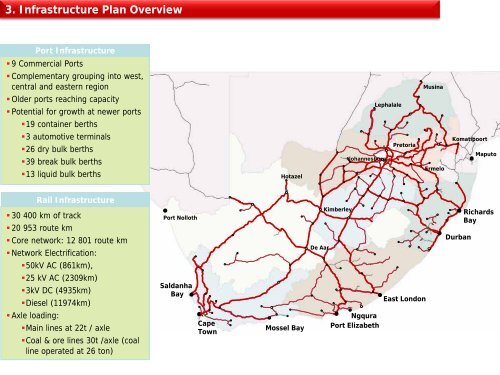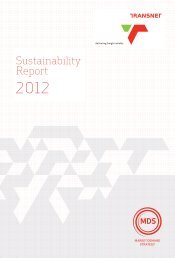3. Infrastructure Plan Overview Port and Rail Network - Transnet
3. Infrastructure Plan Overview Port and Rail Network - Transnet
3. Infrastructure Plan Overview Port and Rail Network - Transnet
You also want an ePaper? Increase the reach of your titles
YUMPU automatically turns print PDFs into web optimized ePapers that Google loves.
<strong>3.</strong> <strong>Infrastructure</strong> <strong>Plan</strong> <strong>Overview</strong><br />
<strong>Port</strong> <strong>and</strong> <strong>Rail</strong> <strong>Network</strong><br />
<strong>Port</strong> <strong>Infrastructure</strong><br />
• 9 Commercial <strong>Port</strong>s<br />
• Complementary grouping into west,<br />
central <strong>and</strong> eastern region<br />
Musina<br />
• Older ports reaching capacity<br />
• Potential for growth at newer ports<br />
•19 container berths<br />
•3 automotive terminals<br />
•26 dry bulk berths<br />
•39 break bulk berths<br />
•13 liquid bulk berths<br />
Luderitz<br />
Hotazel<br />
Johannesburg<br />
Lephalale<br />
Pretoria<br />
Ermelo<br />
Komatipoort<br />
Maputo<br />
<strong>Rail</strong> <strong>Infrastructure</strong><br />
• 30 400 km of track<br />
• 20 953 route km<br />
• Core network: 12 801 route km<br />
• <strong>Network</strong> Electrification:<br />
•50kV AC (861km),<br />
•25 kV AC (2309km)<br />
•3kV DC (4935km)<br />
•Diesel (11974km)<br />
• Axle loading:<br />
•Main lines at 22t / axle<br />
•Coal & ore lines 30t /axle (coal<br />
line operated at 26 ton)<br />
<strong>Port</strong> Nolloth<br />
Saldanha<br />
Bay<br />
Cape<br />
Town<br />
Mossel Bay<br />
Kimberley<br />
De Aar<br />
Ngqura<br />
<strong>Port</strong> Elizabeth<br />
East London<br />
Durban<br />
Richards<br />
Bay<br />
Source: <strong>Transnet</strong> Group <strong>Plan</strong>ning
<strong>3.</strong> <strong>Infrastructure</strong> <strong>Plan</strong> <strong>Overview</strong><br />
Pipeline <strong>Network</strong><br />
Pipeline <strong>Infrastructure</strong><br />
Crude Oil line: 580 km<br />
• Design cap = 6,8 bnl/a<br />
• Current cap = 5,2 bnl/a<br />
Refined Fuels line: 725 km +<br />
±1000km network<br />
• Design cap = 3,5 bnl/a<br />
• Current cap = 4,3 bnl/a<br />
Aviation Turbine Fuel line: 94<br />
km.<br />
• Design cap = 1,2 bnl/a<br />
• Current cap = 1,1 bnl/a<br />
Methane-rich Gas Line: ±570km<br />
• Design cap = 23m GJ pa<br />
• Current cap = 17m GJ pa<br />
PRETORIA WEST<br />
WALTLOO<br />
RUSTENBURG<br />
ELARDUS PARK<br />
AIRPORT<br />
KENDAL<br />
TARLTON<br />
LANGLAAGTE<br />
ALRODE<br />
JAMESON<br />
MEYERTON<br />
PARK<br />
KLERKSDORP<br />
NORTH<br />
WEST<br />
MAGDALA<br />
KROONSTAD<br />
SASOLBURG<br />
BETHLEHEM<br />
GAUTENG<br />
COALBROOK<br />
FREE<br />
STATE<br />
BHT<br />
WILGE<br />
VREDE<br />
VAN REENEN<br />
WITBANK<br />
MPUMALANGA<br />
SECUNDA<br />
“T”<br />
STANDERTON<br />
QUAGGA<br />
NEWCASTLE<br />
VOLKSRUST<br />
INGOGO<br />
FORT MISTAKE<br />
LADYSMITH<br />
REFINED PRODUCTS<br />
CRUDE OIL<br />
GAS<br />
AVTUR<br />
NOT IN USE<br />
FUTURE NMPP PIPELINES<br />
FUTURE TERMINALS<br />
DOUBLE PUMP STATION<br />
PUMP STATIONS<br />
DELIVERY STATIONS / METERS<br />
INTAKE STATIONS<br />
KWAZULU /<br />
NATAL<br />
MOOIRIVER<br />
VRYHEID<br />
SCHEEPERSNEK<br />
EMPANGENI<br />
MAHLABATINI<br />
RICHARDS BAY<br />
HOWICK<br />
DUZI<br />
OCEAN<br />
INDIAN<br />
HILLCREST<br />
MNGENI<br />
FYNNLAND<br />
DURBAN
<strong>3.</strong> <strong>Infrastructure</strong> <strong>Plan</strong> <strong>Overview</strong><br />
General <strong>Plan</strong>ning Principles<br />
• Provide capacity ahead of dem<strong>and</strong><br />
• Ensure sustainability of development plans<br />
• Integrate port, rail <strong>and</strong> pipeline planning<br />
• Align with national road <strong>and</strong> electricity supply<br />
planning<br />
• Align with plans of other authorities<br />
• Provide capacity through operational efficiencies<br />
before infrastructure provision
<strong>3.</strong> <strong>Infrastructure</strong> <strong>Plan</strong> <strong>Overview</strong><br />
Sustainability<br />
• NEMA’s definition of sustainability<br />
… the integration of social, economic <strong>and</strong> environmental<br />
factors into planning, implementation <strong>and</strong> decision-making<br />
so as to ensure that development serves present <strong>and</strong> future<br />
generations”<br />
• Principles informing <strong>Transnet</strong>’s Sustainability Framework<br />
– Ensure sound accountability <strong>and</strong> governance.<br />
– Achieve economic returns greater than the cost of capital.<br />
– Develop world-class infrastructure.<br />
– Create a workplace where our people can excel.<br />
– Care for the communities in which we operate.<br />
– Manage the environment responsibly.<br />
<strong>Transnet</strong>’s strategy for Sustainable Development <strong>and</strong><br />
Environmental Management is currently under development<br />
Source: <strong>Transnet</strong> Capital Projects
<strong>3.</strong> <strong>Infrastructure</strong> <strong>Plan</strong> <strong>Overview</strong><br />
Mega Projects: <strong>Overview</strong> <strong>and</strong> Progress to date<br />
Project<br />
Progress<br />
Objective<br />
to date<br />
1. Iron Ore Line Phase 1B 83% • To increase the iron ore export channel<br />
(Sishen/Saldanha) capacity 47mtpa (Phase 1B);<br />
• The increased dem<strong>and</strong> in basic commodities<br />
world-wide has led to the mines (Kumba <strong>and</strong><br />
Assmang) increasing their production<br />
requirements to meet international dem<strong>and</strong>;<br />
• The project consists of the acquisition of rolling<br />
<strong>3.</strong> Iron Ore Line Phase 1C 25% • To stock increase <strong>and</strong> the the upgrade iron ore of export infrastructure channel involving to<br />
three 60mtpa <strong>Transnet</strong> to meet operating the increase divisions in production (i.e. Freight at the<br />
mines <strong>Rail</strong>, National over the <strong>Port</strong>s medium Authority term <strong>and</strong> <strong>Port</strong><br />
• The Operations). bulk terminal services will also require<br />
debottlenecking through the upgrading of<br />
conveyor systems to achieve the average<br />
4. Cape Town Container 54% • To shiploading increase rates capacity of 7500 of the tph. existing facility from<br />
Expansion<br />
• 600 The 000 marine TEUs/annum solution includes to 900 the 000 concept TEUs/annum of<br />
(0.9m TEUs)<br />
to staggered meet the shiploading. increase in dem<strong>and</strong> arising mainly<br />
from the Western Cape region.<br />
• The project entails increasing<br />
• stacking area;<br />
• replacement <strong>and</strong> acquisition of additional port<br />
h<strong>and</strong>ling equipment; <strong>and</strong><br />
• deepening of container berths
<strong>3.</strong> <strong>Infrastructure</strong> <strong>Plan</strong> <strong>Overview</strong><br />
Mega Projects: <strong>Overview</strong> <strong>and</strong> Progress to date<br />
Project<br />
5. Ngqura Container<br />
Termina<br />
6. Durban Harbour<br />
Entrance Channel<br />
Widening <strong>and</strong><br />
Deepening<br />
7. DCT<br />
Reengineering<br />
8. New Multi-product<br />
Pipeline<br />
Progress<br />
Objective<br />
to date<br />
84% • Provision of a full service container terminal with 2 berths<br />
in the first phase which will provide 750 000 TEUs/a<br />
capacity.<br />
• The terminal commenced operations in October 2009<br />
<strong>and</strong> plans are in place to utilise Ngqura Container<br />
87% • To widen <strong>and</strong> deepen the entrance channel of the <strong>Port</strong> of<br />
Terminal as a transshipment hub.<br />
Durban to enable safe navigation <strong>and</strong> to accommodate<br />
the trend of increasing vessel sizes.<br />
Dredging works <strong>and</strong> construction of a fixed s<strong>and</strong> bypass<br />
52% • To increase the capacity of the Durban Container<br />
system are the main components of the project.<br />
Terminal from 1.98 million TEUs/annum to 2.3 million<br />
TEUs/annum <strong>and</strong> ultimately to 2.9 million TEUs/annum.<br />
• The project will also replace equipment that has<br />
deteriorated over a working life of more than 20 years to<br />
23% •<br />
improve<br />
To build a<br />
operational<br />
550 kilometre<br />
efficiencies<br />
long new 24 inch trunkline from<br />
Durban to Jameson Park (Gauteng) to address the<br />
increased dem<strong>and</strong> for fuel in Gauteng <strong>and</strong> surrounding<br />
areas.<br />
• The trunk line will connect an inl<strong>and</strong> <strong>and</strong> coastal terminal<br />
with significant storage capacity.<br />
• Construction of the trunkline commenced in February<br />
2008 <strong>and</strong> is considered a strategic project of national<br />
importance.
PROGRAMME<br />
1 Introduction Chris Wells: Acting Group Chief Executive 09:00 –<br />
2 Policy & Regulation Vuyo Kahla: Group Executive: Office of the<br />
09:15<br />
09:15 –<br />
context<br />
Group Chief Executive<br />
09:30<br />
3 <strong>Infrastructure</strong> <strong>Plan</strong><br />
<strong>Overview</strong><br />
4 Dem<strong>and</strong> Forecast <strong>and</strong><br />
Moira Moses: Group Executive: <strong>Transnet</strong><br />
Capital Projects<br />
Francois Meyer: <strong>Plan</strong>ning Director, <strong>Rail</strong>:<br />
09:30 –<br />
09:45<br />
09:45 –<br />
<strong>Rail</strong> <strong>Plan</strong>ning<br />
Group <strong>Plan</strong>ning<br />
11:00<br />
BREAK<br />
5 Pipeline <strong>Plan</strong>ning Lennie Moodley: Chief Operating Officer: 11:30 –<br />
6 <strong>Port</strong> <strong>Plan</strong>ning<br />
<strong>Transnet</strong> Pipelines<br />
Moira Moses: Group Executive: <strong>Transnet</strong><br />
11:45<br />
11:45 –<br />
Capital Projects<br />
12:15<br />
7 Five-year Capital<br />
Phumelele Motsoahae: <strong>Plan</strong>ning Specialist:<br />
12:15 –<br />
Investment <strong>Plan</strong> <strong>and</strong><br />
Group<br />
Chris Wells:<br />
<strong>Plan</strong>ning<br />
Acting Group Chief Executive 12:30<br />
8<br />
Concluding<br />
Questions <strong>and</strong><br />
remarks<br />
12:30 –
4. Integrated Dem<strong>and</strong> Forecast<br />
Objectives<br />
• Creating capacity ahead of dem<strong>and</strong> is one of the primary<br />
objectives of <strong>Transnet</strong><br />
• Freight Forecasting is an important planning tool to<br />
underst<strong>and</strong> how dem<strong>and</strong> for transportation capacity will<br />
change in future<br />
• The lead times to infrastructure provision are often 5-7 years<br />
- the Freight Dem<strong>and</strong> Model need to take a 30 year view to<br />
enable <strong>Transnet</strong> to build a capital requirement picture for the<br />
longer term<br />
Source: <strong>Transnet</strong> Group <strong>Plan</strong>ning
4. Integrated Dem<strong>and</strong> Forecast<br />
Dem<strong>and</strong> Model Methodology<br />
Step 1:<br />
Determine commodities (65 classes) produced <strong>and</strong><br />
consumed in South Africa in 2007/8<br />
Step 2:<br />
Allocate freight production <strong>and</strong> consumption to 352<br />
magisterial districts (MD)<br />
Freight Supply Density<br />
(Production Areas)<br />
Macro-economic<br />
Input /Output data<br />
Actual data –<br />
publications <strong>and</strong> interviews<br />
1 2<br />
National<br />
Apportionment<br />
I-O model<br />
Magisterial Districts<br />
65 Commodities<br />
Freight Dem<strong>and</strong> Density<br />
(Consumption Areas)<br />
Source: <strong>Transnet</strong> Group <strong>Plan</strong>ning
4. Integrated Dem<strong>and</strong> Forecast<br />
Dem<strong>and</strong> Model Methodology<br />
Step 1: Determine commodities (65 classes) produced <strong>and</strong> consumed in South Africa in 2007/8<br />
Step 2: Allocate freight production <strong>and</strong> consumption to 352 magisterial districts (MD)<br />
Step 3: Forecast surface growth for 30 years (regional for each of 65 commodities)<br />
Macro-economic<br />
Input /Output data<br />
Actual data –<br />
publications <strong>and</strong> interviews<br />
1 2 3<br />
National<br />
Apportionment<br />
I-O model<br />
Magisterial Districts<br />
65 Commodities<br />
Surface<br />
Forecast<br />
30 years<br />
Macro-economic<br />
forecasts<br />
Source: <strong>Transnet</strong> Group <strong>Plan</strong>ning

















